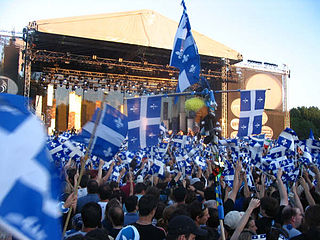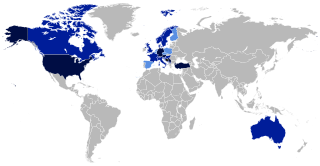
A nation-state is a political unit where the state, a centralized political organization ruling over a population within a territory, and the nation, a community based on a common identity, are congruent. It is a more precise concept than "country", since a country does not need to have a predominant national or ethnic group.
A nation is a large type of social organization where a collective identity has emerged from a combination of shared features across a given population, such as language, history, ethnicity, culture, territory or society. Some nations are constructed around ethnicity while others are bound by political constitutions.
An ethnicity or ethnic group is a grouping of people who identify with each other on the basis of perceived shared attributes that distinguish them from other groups. Those attributes can include a common nation of origin, or common sets of ancestry, traditions, language, history, society, religion, or social treatment. The term ethnicity is often used interchangeably with the term nation, particularly in cases of ethnic nationalism.
French Canadians, or Franco-Canadians, are an ethnic group who trace their ancestry to French colonists who settled in France's colony of Canada beginning in the 17th century.

Quebec nationalism or Québécois nationalism is a feeling and a political doctrine that prioritizes cultural belonging to, the defence of the interests of, and the recognition of the political legitimacy of the Québécois nation. It has been a movement and a central issue in Quebec politics since the beginning of the 19th century. Québécois nationalism has seen several political, ideological and partisan variations and incarnations over the years.

National identity is a person's identity or sense of belonging to one or more states or one or more nations. It is the sense of "a nation as a cohesive whole, as represented by distinctive traditions, culture, and language". National identity may refer to the subjective feeling one shares with a group of people about a nation, regardless of one's legal citizenship status. National identity is viewed in psychological terms as "an awareness of difference", a "feeling and recognition of 'we' and 'they'". National identity also includes the general population and diaspora of multi-ethnic states and societies that have a shared sense of common identity identical to that of a nation while being made up of several component ethnic groups. Hyphenated ethnicities are an example of the confluence of multiple ethnic and national identities within a single person or entity.
A stateless nation is an ethnic group or nation that does not possess its own sovereign state and is not the majority population in any nation state. The term "stateless" implies that the group has the right to self-determination, to establish an independent nation with its own government. Members of stateless nations may be citizens of the country in which they live, or they may be denied citizenship by that country. Stateless nations are usually not represented in international sports or in international organisations such as the United Nations. Nations without a state are classified as fourth-world nations. Some stateless nations have a history of statehood, while some were always stateless.

Canadian identity refers to the unique culture, characteristics and condition of being Canadian, as well as the many symbols and expressions that set Canada and Canadians apart from other peoples and cultures of the world. Primary influences on the Canadian identity trace back to the arrival, beginning in the early seventeenth century, of French settlers in Acadia and the St. Lawrence River Valley, and of English, Scottish and Irish settlers in Newfoundland and the Maritimes, the British conquest of New France in 1759, the migration of United Empire Loyalists to Upper Canada and New Brunswick, and the ensuing dominance of French and British culture in the gradual development of both an imperial and national identity.
Civic nationalism, also known as democratic nationalism and liberal nationalism, is a form of nationalism that adheres to traditional liberal values of freedom, tolerance, equality, individual rights and is not based on ethnocentrism. Civic nationalists often defend the value of national identity by saying that individuals need it as a partial shared aspect of their identity in order to lead meaningful, autonomous lives and that democratic polities need a national identity to function properly.
In sociology, people who permanently resettle to a new country are considered immigrants, regardless of the legal status of their citizenship or residency. The United States Census Bureau (USCB) uses the term "generational status" to refer to the place of birth of an individual or an individual's parents. First-generation immigrants are the first foreign-born family members to gain citizenship or permanent residency in the country. People beyond the first generation are not "immigrants" in the strictest sense of the word and, depending on local laws, may have received citizenship from birth. The categorization of immigrants into generations helps sociologists and demographers track how the children and subsequent generations of immigrant forebears compare to sections of the population that do not have immigrant background or to equivalent generations of prior eras.
Among scholars of nationalism, a number of types of nationalism have been presented. Nationalism may manifest itself as part of official state ideology or as a popular non-state movement and may be expressed along civic, ethnic, cultural, language, religious or ideological lines. These self-definitions of the nation are used to classify types of nationalism, but such categories are not mutually exclusive and many nationalist movements combine some or all of these elements to varying degrees. Nationalist movements can also be classified by other criteria, such as scale and location.
The English people are an ethnic group and nation native to England, who speak the English language, a West Germanic language, and share a common history and culture. The English identity began with the Anglo-Saxons, when they were known as the Angelcynn, meaning race or tribe of the Angles. Their ethnonym is derived from the Angles, one of the Germanic peoples who migrated to Great Britain around the 5th century AD.

Americans are the citizens and nationals of the United States. The United States is home to people of many racial and ethnic origins; consequently, American culture and law do not equate nationality with race or ethnicity, but with citizenship and an oath of permanent allegiance.

Canadians are people identified with the country of Canada. This connection may be residential, legal, historical or cultural. For most Canadians, many of these connections exist and are collectively the source of their being Canadian.
American ancestry refers to people in the United States who self-identify their ancestral origin or descent as "American", rather than the more common officially recognized racial and ethnic groups that make up the bulk of the American people. The majority of these respondents are visibly White Americans, who are far removed from and no longer self-identify with their original ethnic ancestral origins. The latter response is attributed to a multitude of generational distance from ancestral lineages, and these tend be Anglo-Americans of English, Scotch-Irish, Welsh, Scottish or other British ancestries, as demographers have observed that those ancestries tend to be recently undercounted in U.S. Census Bureau American Community Survey ancestry self-reporting estimates.

Bosnians are people native to the country of Bosnia and Herzegovina, especially the historical region of Bosnia. As a common demonym, the term Bosnians refers to all inhabitants/citizens of the country, regardless of any ethnic, cultural or religious affiliation. It can also be used as a designation for anyone who is descended from the region of Bosnia. Also, a Bosnian can be anyone who holds citizenship of the state of Bosnia and Herzegovina and thus is largely synonymous with the all-encompassing national demonym Bosnians and Herzegovinians.
Quebecers or Quebeckers are people associated with Quebec. The term is most often used in reference to descendants of the French settlers in Quebec and people of any ethnicity who live in the province.
Monoethnicity is the existence of a single ethnic group in a given region or country. It is the opposite of polyethnicity.
Ethnic nationalism, also known as ethnonationalism, is a form of nationalism wherein the nation and nationality are defined in terms of ethnicity, with emphasis on an ethnocentric approach to various political issues related to national affirmation of a particular ethnic group.

Arab identity is the objective or subjective state of perceiving oneself as an Arab and as relating to being Arab. Like other cultural identities, it relies on a common culture, a traditional lineage, the common land in history, shared experiences including underlying conflicts and confrontations. These commonalities are regional and in historical contexts, tribal. Arab identity is defined independently of religious identity, and pre-dates the spread of Islam and before spread of Judaism and Christianity, with historically attested Arab Muslim tribes and Arab Christian tribes and Arab Jewish tribes. Arabs are a diverse group in terms of religious affiliations and practices. Most Arabs are Muslim, with a minority adhering to other faiths, largely Christianity, but also Druze and Baháʼí.









